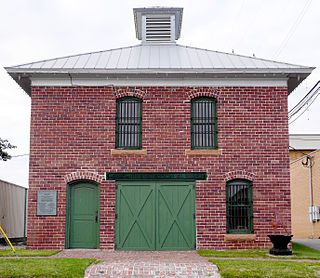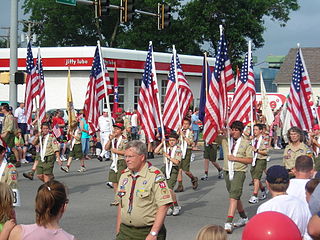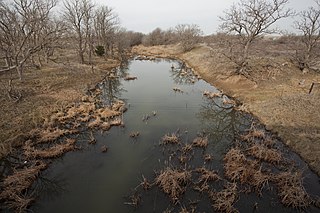
Kiowa County is a county located in the southwestern part of the U.S. state of Oklahoma. As of the 2010 census, the population was 9,446. Its county seat is Hobart. The county was created in 1901 as part of Oklahoma Territory. It was named for the Kiowa people.

Grady County is a county located in the U.S. state of Oklahoma. As of the 2010 census, the population was 52,431. Its county seat is Chickasha. It was named for Henry W. Grady, an editor of the Atlanta Constitution and southern orator.

Canadian County is a county located in the U.S. state of Oklahoma. As of the 2010 census, the population was 115,541, making it the fourth-most populous county in Oklahoma. Its county seat is El Reno.

Caddo County is a county located in the U.S. state of Oklahoma. As of the 2010 census, the population was 29,600. Its county seat is Anadarko. Created in 1901 as part of Oklahoma Territory, the county is named for the Caddo tribe who were settled here on a reservation in the 1870s. Caddo County is immediately west of the seven-county Greater Oklahoma City metro area, and although is not officially in the metro area, it has many economic ties in this region.

Scouting in Oklahoma has a long history, from the 1910s to the present day, serving thousands of youth in programs that suit the environment in which they live.

Chickasha is a city in and the county seat of Grady County, Oklahoma, United States. The population was 16,036 at the 2010 census. Chickasha is home to the University of Science and Arts of Oklahoma. The city is named for and strongly connected to Native American heritage, as "Chickasha" (Chikashsha) is the Choctaw word for Chickasaw.

Verden is a town in western Grady County, Oklahoma, United States. It abuts the Caddo County line, and is probably best known as the site of the 1865 Camp Napoleon Council. The population was 530 at the 2010 census, a decline from 659 in 2000.
A spring creek is a stream that flows from a spring.

The Washita River is a river in the states of Texas and Oklahoma in the United States. The river is 295 miles (475 km) long and terminates at its confluence with the Red River, which is now part of Lake Texoma on the Texas–Oklahoma border.

Spring Creek is an unincorporated community in Caddo County, Oklahoma, United States. It is about 6 miles (10 km) south-southwest of Cogar, and just east of the Spring Creek watercourse that feeds into Lake Chickasha. It has a cemetery, church, schoolhouse, and general store still standing. The cemetery and church are still used. The remaining general store is now a house. The schoolhouse is block and was built around the turn of the 20th century. The surrounding area is very sandy and features much red rock.

Fort Cobb Reservoir is a reservoir located in Caddo County in the U.S. state of Oklahoma. It impounds the waters of Cobb (Pond) Creek and Lake Creek. The lake covers approximately 4,000 acres (16 km²) of water and 45 mi (72 km) of shoreline. Its drainage area is 285 square miles (740 km2). It was constructed in 1958. The towns of Carnegie, Fort Cobb, and Eakly are located nearby.

Cogar is a small unincorporated rural community in Caddo County, Oklahoma, United States. It is located about 12 miles west of Minco, Oklahoma on Oklahoma State Highway 37, and about 5 miles east of Salyer Lake on Oklahoma State Highway 152. The post office was established March 25, 1902, and discontinued September 30, 1954. The exterior of the abandoned W.S. Kelly gas station and general store in Cogar can be seen in the 1988 movie Rain Man.
Carrizo Creek is a 145-mile-long (233 km) river in New Mexico and Texas. It is a tributary of Rita Blanca Creek, itself a tributary of the Canadian River. Via the Arkansas and Mississippi rivers, water from Carrizo Creek eventually reaches the Gulf of Mexico. It is sometimes also known as the Carrizo River.
Palo Duro Creek is formed in Texas from the junction of North Palo Duro Creek and South Palo Duro Creek north of Morse, Texas. The creek continues generally northeast until it becomes a tributary of the Beaver River in Oklahoma at a point east-northeast of Hardesty, Oklahoma, west of Balko, Oklahoma, and north of U.S. Route 412 near the Texas County/Beaver County line, downstream from the Optima Lake project.
Spring Creek Lake is located on Spring Creek in Roger Mills County about 14 miles north of Cheyenne on US Route 283 and 8 miles west on SH-33, in the State of Oklahoma. It is inside the Black Kettle National Grassland, which is managed by the Cibola National Forest. It is 60 acres in size.
Spring Creek originates in Eastern Oklahoma near the town of Kansas, and flows generally southwest about 34 miles through Delaware, Cherokee, and Mayes counties before emptying into Fort Gibson Lake on the Grand (Neosho) River. Throughout its roughly 117,000 acre watershed, the creek is fed by small springs which contribute most of the estimated 15 million gallons of water that flow through it per day. Spring Creek is listed as having high quality water, being one of only five bodies of water in the state having this rating.
The Little Washita River is situated generally between Chickasha and Lawton in southwestern Oklahoma. Its watershed comprises about 236 square miles over parts of Caddo, Comanche, and Grady counties. The Little Washita is a tributary of the Washita River, and joins that watercourse southeast of Chickasha. The Washita River then drains into the Red River on the Oklahoma-Texas border.
Salyer Lake is a reservoir in Caddo County, Oklahoma at an elevation of 1,453 feet. It is about 17 miles west of Minco, Oklahoma on SH-37 and SH-152. The lake is about 6 acres in size. Available fish species include Largemouth bass.
Sugar Creek rises west of Hinton in Caddo County, Oklahoma. It travels generally south-southeast directly through Lookeba and the northeast corner of Binger. It flows along the west boundary of Gracemont before turning more southeasterly and joining the Washita River to the east of Anadarko, Oklahoma.
Cobb Creek, also known as Pond Creek, is a watercourse in Washita and Caddo counties in Oklahoma. It originates in Washita County just south of the Custer-Washita county line, being south of Weatherford, Oklahoma. It flows generally south-southeast, feeding into the 157-acre Crowder Lake, also known as the Cobb Creek Watershed Dam No. 1. It continues below the lake, passing through Colony, Oklahoma, after which it turns more southeasterly and crosses into Caddo County. It joins Fort Cobb Lake from the west. Cobb Creek continues south-southeast below that lake, and ends when it becomes a tributary of the Washita River just southwest of Fort Cobb, Oklahoma.










